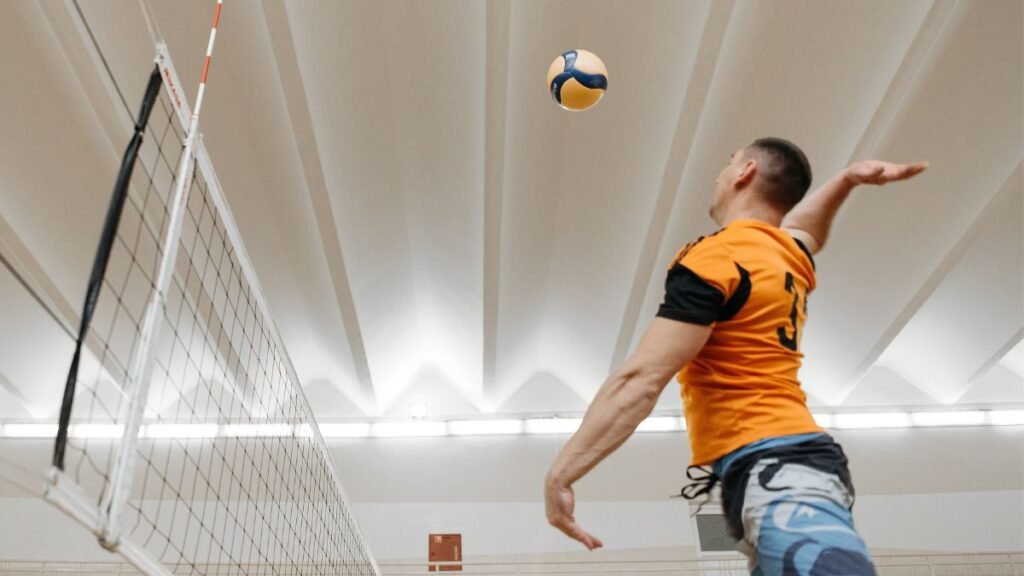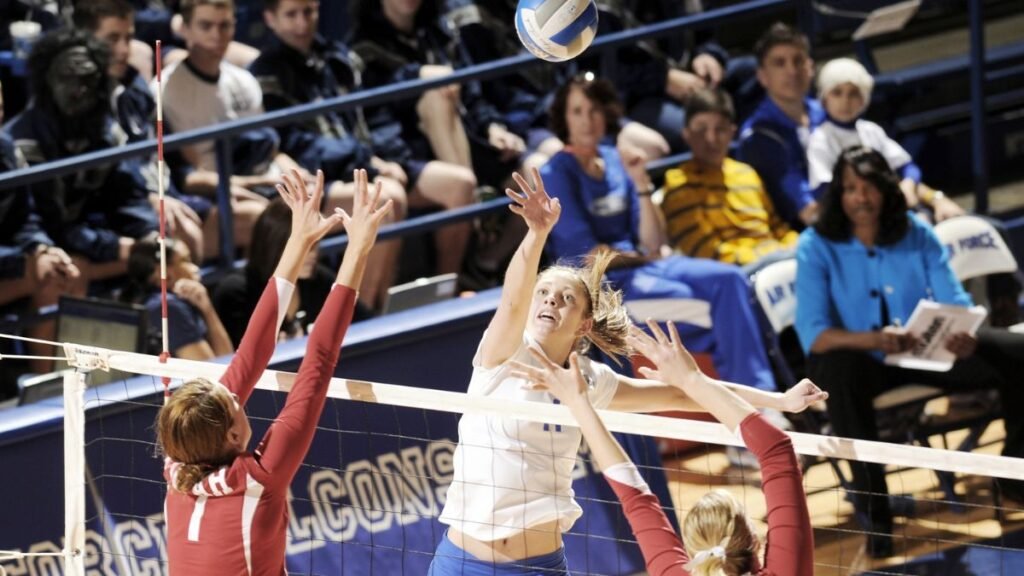Introduction

Ever wondered how Brazil dominates volleyball with such precision? Their success isn’t just talent—it’s strategy. Volleyball Positions Explained demonstrates how mastering court positions and player roles fosters a seamless team dynamic, transforming good players into champions.
This dynamic is not merely about individual skills; it encompasses a deep understanding of the game, including the positions in volleyball, where each player knows their role and how to execute it effectively.
Brazil’s teams train rigorously to ensure that every player is not only proficient in their designated position but also adaptable to changing game situations, enhancing overall team synergy.
In this sport, “position” has two meanings: where you stand and what you do. Brazilian teams excel by blending both. Their techniques offer seven powerful strategies anyone can adopt. These strategies emphasize the importance of effective communication, quick decision-making, and strategic thinking, enabling players to anticipate their opponents’ moves and respond accordingly.
By focusing on both the physical and mental aspects of the game, players can develop a more comprehensive skill set that prepares them for various challenges on the court.
Whether you’re a beginner or an intermediate player, understanding these tactics can boost your performance. Let’s break down how Brazil’s approach can elevate your game.
By incorporating these strategies into your training, you can improve not only your individual skills but also your ability to work effectively as part of a team, leading to greater success in matches.
Key Takeaways
- Brazil’s volleyball dominance stems from strategic mastery.
- Court positioning and player roles are equally crucial.
- Seven adaptable tactics can improve team coordination.
- Position mastery separates good players from great ones.
- Strategies suit all skill levels for immediate impact.
What Are the Positions in Volleyball? A Beginner’s Breakdown
Six numbered zones dictate every move on the volleyball court. Each spot (1–6) aligns with specific rules and responsibilities, creating a framework for team success.
Each zone has its own strategic importance, as players must be aware of their positioning to optimize both offensive and defensive plays. Brazil’s dominance stems from exploiting this structure with precision, allowing players to seamlessly transition between roles while maintaining their focus on team objectives.
Static Positions, Dynamic Roles
Positions 1–6 are fixed, but player roles shift fluidly. For example, the setter might occupy Position 3 in one rotation but defend Position 6 later.
This blend of structure and adaptability fuels elite play. Each player’s ability to switch roles based on the game’s flow is crucial; it not only enhances team dynamics but also keeps opponents guessing. This strategic flexibility allows teams to respond effectively to various game situations, making it essential for players to develop a deep understanding of each position’s requirements and how they interconnect.
Specialists, such as liberos (wearing contrasting jerseys), thrive in back-row zones (positions 5 or 6), focusing on digs and passes. Their primary role is to enhance the team’s defensive capabilities, ensuring that every ball is kept in play. Meanwhile, middle blockers dominate the front (Positions 3 or 4) for quick attacks, playing a pivotal role in both offense and defense.
They are tasked with blocking opponents’ spikes while also being prepared to execute fast attacks themselves. Learn more about volleyball positions to refine your strategy, as understanding these roles will significantly impact your gameplay and overall team performance.
Why Rotation Knowledge Wins Games
Clockwise rotations after winning serves force players to master all areas of the court, enhancing their versatility and adaptability. A player might start in Position 1 (right back) but rotate to Position 4 (left front) for blocking, showcasing their ability to contribute in various roles as the game progresses. Anticipating these shifts not only enhances individual skill sets but also fosters teamwork and communication, which separates good teams from champions.
Brazilian squads drill rotations relentlessly, ensuring seamless transitions that can catch opponents off guard. Their success proves that mastering court logistics is as vital as raw skill, as understanding one’s position and responsibilities during each rotation can lead to strategic advantages.
By practicing these rotations, players develop a keen sense of timing and positioning, allowing them to respond quickly to changing situations on the court. This preparation is essential for maintaining momentum and controlling the pace of the game.
The Setter: The Team’s Offensive Architect
Great setters turn chaos into opportunity on the court. They’re the team’s quarterback, transforming passes into explosive attacks.
Brazilian volleyball thrives because its setters master both precision and deception. This mastery is not merely about making accurate sets; it involves reading the game, anticipating the movements of both teammates and opponents, and executing plays that exploit defensive weaknesses.
The ability to create space and time for hitters is a hallmark of exceptional setters, making them invaluable in high-pressure situations.
Key Responsibilities and Skills
Setters operate from Position 1 or 2, handling the ball’s second touch. Their decisions dictate whether a play becomes a quick strike or a feigned attack. Footwork is critical—elite setters pivot to face hitters while maintaining balance.
Communication separates good setters from legends. Hand signals hidden behind their backs coordinate players without alerting blockers. Brazilian teams drill these until they’re instinctive.
Brazilian Setter Strategies for Precision Plays
Deception wins matches. Brazil’s setters fake backsets to wrong-foot blockers, then deliver quick dumps over the net. Their signature move? A jump set that disguises the ball’s trajectory until the last second.
To train like a pro, focus on these drills:
| Drill | Purpose | Reps |
|---|---|---|
| Backset Accuracy | Improve blind passes to hitters | 3 sets of 20 |
| Footwork Ladder | Enhance positioning speed | 5 minutes daily |
| Signal Recognition | Sync with hitters mid-play | 10 plays per rotation |
Remember: A setter’s offense isn’t just about power—it’s about outthinking the opponent. Study Brazil’s rotations, and you’ll see why their setters are feared worldwide.
Middle Blocker: The Defensive Wall
Middle blockers are the unsung heroes of volleyball’s front line. Operating primarily in Position 3, they transform the net into a barrier opponents dread. These players not only excel in blocking attacks but also play a crucial role in initiating counterattacks by quickly transitioning from defense to offense.
Brazil’s success hinges on its blockers mastering both defense and lightning-fast counterattacks. Their ability to read the game and anticipate the opponent’s moves allows them to effectively shut down powerful spikes while also creating opportunities for their team to score. The synergy between the middle blockers and setters is vital, as it enables seamless plays that can catch the opposition off guard.
Blocking Techniques and Quick Attacks
Proper hand positioning separates good middle blockers from great ones. Hands must penetrate the net’s plane, fingers spread to deflect spikes effectively. This technique is essential because the angle and placement of the hands can determine whether a block is successful or not.
Timing is critical—jump too early, and hitters tool the block; too late, and the ball sails past. A well-timed jump not only increases the chances of a successful block but also intimidates the opposing hitters, forcing them to adjust their attacks.
Brazilian teams execute double blocks, where two players simultaneously seal the net. This strategy is particularly effective against strong attackers, as it forces them into errors or predictable angles, making it easier for the defense to anticipate and react.
For quick attacks, middle blockers sync with setters using slide techniques, darting laterally to exploit gaps. This lateral movement requires not only coordination but also an acute awareness of the court dynamics, enabling blockers to position themselves optimally in response to the setter’s actions and the hitter’s approach.
How Brazilian Teams Dominate the Net
Synchronized footwork lets Brazil’s blockers react mid-air. They read setters’ hands, adjusting to block line or cross-court shots. This intricate dance requires not just agility but also an innate understanding of the game’s rhythm. Their signature move?
The “read-and-react” strategy, where blockers delay jumps to mirror hitters’ approach, allowing them to anticipate the trajectory of the ball and position themselves accordingly. This technique is crucial, as it can mean the difference between a successful block and an easy point for the opposing team.
Combos with setters create unstoppable, quick attacks. A well-timed one-foot slide attack, like Brazil’s famous “X-play,” leaves defenders scrambling. This particular play involves the middle blocker sliding behind the setter, creating a deceptive angle that catches the defense off guard.
These tactics demand precision but deliver explosive results, showcasing the high level of coordination and trust between players. The seamless execution of these strategies exemplifies why Brazilian teams are renowned for their offensive prowess and ability to keep opponents on their toes.
| Drill | Focus | Repetitions |
|---|---|---|
| Penetration Blocks | Hand placement over the net | 3 sets of 15 |
| Slide Approach | Timing for fast middle hits | 10 reps per side |
| Double Block Jumps | Synchronizing with teammates | 5 rotations |
Master these techniques, and your defense will mirror Brazil’s championship-caliber play. The net isn’t just a boundary—it’s your domain.
Outside Hitter: The Primary Attacker
Every championship volleyball team relies on outside hitters to deliver crushing attacks. These players dominate Position 4, combining power with strategic versatility. Brazilian squads elevate this role through precision angle attacks and back row strikes.
The outside hitter’s ability to read the game and adapt to defensive setups is crucial; they must not only execute powerful spikes but also recognize when to tip the ball or utilize off-speed shots to catch the defense off guard. This multifaceted approach keeps opponents guessing and creates scoring opportunities from various angles.
Left-Side Dominance and Versatility
Right-handed outside hitters tend to gain a natural advantage when attacking from the left side. Their dominant arm generates maximum torque when swinging cross-court, enabling them to produce powerful and precise shots that can easily overwhelm the defense.
Brazil’s national team optimizes this by training hitters to adjust approach angles mid-air, enabling them to adapt their attacks based on the positioning of blockers and defenders. This adaptability is crucial in high-pressure situations where split-second decisions can determine the outcome of a point.
Key techniques include:
- Three-step approach starting outside the court, which helps build momentum and creates a more dynamic attack
- Shoulder rotation for power generation, ensuring that the hitter can deliver a strong and effective strike
- Arm swing finishing across the body, which not only adds to the power of the hit but also allows for greater control and placement of the ball, making it harder for defenders to predict the trajectory. This combination of techniques enhances the outside hitter’s ability to score and keeps the opposing team on their toes.

Brazilian-Inspired Power Hits
Elite attackers master the “wipe” shot—hitting off blockers’ hands out of bounds. Brazil’s Olympic teams use this when facing tight double blocks. The move requires precise timing and wrist control.
Back row attacks from Position 5 add another dimension. Players must:
- Time jumps behind the 3-meter line
- Maintain a downward ball trajectory
- Land without touching the attack line
| Drill | Focus Area | Progression |
|---|---|---|
| Angle Attack | Cross-court precision | 5 zones target practice |
| Wipe Shot | Block deflection | Partner blocks required |
| Back Row Approach | Timing from deep | Video analysis after |
Transitioning from serve-receive to attack separates good outside hitters from great ones. Brazilian coaches drill this through rapid rotations and instant reaction exercises. The result? A relentless attacker ready for any play.
Opposite Hitter: The Right-Side Specialist
Position 2 specialists create scoring opportunities while anchoring the team’s block. These opposite hitters face unique challenges, often matching up against opponents’ strongest attackers. This position is crucial not only for offensive plays but also for defensive strategies, as they must read the game effectively and anticipate the opponent’s moves.
Brazilian teams optimize this role through strategic rotations and specialized training, focusing on enhancing agility, timing, and decision-making skills. Coaches emphasize the importance of developing a versatile skill set, enabling opposite hitters to adapt to various game situations and make significant contributions to both scoring and blocking efforts.
Balancing Defense and Offense
The right side demands excellence in both blocking and attacking. Players must:
- Time jumps to seal the net against outside hitters
- Transition quickly for back-row pipe attacks
- Maintain serve-receive positioning in rotation
Brazil’s national team drills slide defense transitions relentlessly. Their opposites master the “read-and-step” technique, adjusting footwork to mirror attackers’ approaches. This creates impenetrable double blocks when paired with middle blockers.
Why Left-Handed Players Thrive Here
Natural swing mechanics give lefties an edge in Position 2. Their cross-body attacks from the right side create sharper angles against blockers, allowing them to exploit gaps in the defense that right-handed players might struggle to reach.
This advantage is particularly pronounced in high-pressure situations where precision and speed are crucial. Brazilian coaches specifically recruit left-handed opposites for these advantages, recognizing their unique ability to disrupt defensive formations and create scoring opportunities:
| Advantage | Impact | Brazilian Example |
|---|---|---|
| Cross-court angles | Beats line blockers | Ricardinho’s 2016 Olympic plays, where his left-handed strikes consistently found openings |
| Serve reception | Strong right-side passing | Wallace’s perfect serve ratings showcase his ability to handle tough serves effectively |
| Back-row attacks | Unpredictable pipe shots | Leal’s championship-winning spikes, which often caught defenders off guard with their unexpected angles |
These factors contribute significantly to the overall dynamics of the game, as left-handed players can create more diverse attacking strategies that keep opponents guessing and enhance their team’s offensive capabilities. Furthermore, their ability to switch up plays mid-attack adds an element of surprise that can be pivotal in tight matches, ultimately leading to greater success on the court.
To develop offense like Brazil’s stars, practice these drills:
- Approach jumps from behind the 3-meter line
- Quick transitions from block to attack position
- Target hitting against shifted blockers
Libero and Defensive Specialist: The Backcourt Guardians
No jersey stands out more than the contrasting colors of a libero. These defensive specialists operate under unique rules, wearing distinct uniforms to signify their focus on back-row excellence. Their primary responsibility is to ensure that the ball is kept in play, showcasing exceptional defensive skills and agility.
Brazilian teams treat this role as their secret weapon against powerful attacks, relying on liberating the team from pressure by making crucial digs and accurate passes.
The libero’s ability to read the game and anticipate the opponent’s moves is vital, as they often serve as the backbone of the defense, orchestrating plays from the backcourt and enabling seamless transitions to offense.

Digging and Serve-Receive Secrets
Liberos face strict limitations—they cannot attack above net height or overhead set from the front zone. Their value comes from:
- Lightning-fast reaction digs using Brazil’s “pancake” technique (slapping the floor to save spikes)
- Precision serve-receive positioning to initiate clean offensive plays
- Emergency ball recoveries with sprawling one-arm saves
Olympic-level defensive specialists train in these scenarios:
- Reading attackers’ shoulder angles mid-air
- Adjusting the base position based on the setter’s location
- Communicating coverage gaps with hand signals
Brazilian Defensive Agility Drills
Brazil’s national team dominates with these backcourt innovations:
| Drill | Purpose | Brazilian Twist |
|---|---|---|
| Jersey Color Recognition | Quick libero substitution awareness | Coaches randomly change jerseys mid-drill |
| Sprawl-to-Stand | Rapid recovery after floor digs | Added blindfolded repetitions |
| Serve Shadowing | Anticipating serve trajectories | Using uneven surfaces to simulate bad passes |
Master these techniques, and your team will mirror Brazil’s legendary back row resilience. The libero isn’t just a position—it’s the foundation of championship defense.
7 Winning Strategies Inspired by Brazilian Volleyball
Brazil’s volleyball dominance stems from seven core strategies that redefine competitive play. These tactics blend technical precision with psychological warfare, creating a blueprint for consistent success.
Each strategy is meticulously crafted to exploit opponents’ weaknesses while maximizing Brazil’s strengths on the court. Let’s analyze how they transform ordinary teams into championship contenders, highlighting the innovative approaches that have led to their remarkable achievements in international competitions.
1. Dynamic Serve-Receive Formations
Brazilian teams adjust formations based on server tendencies. They employ:
- Stacked alignments against powerful servers
- Spread formations for float serve specialists
- Libero-driven coverage in rotation gaps
Olympic gold medalist Serginho often shifted between Positions 5 and 6 mid-rally, anticipating serve trajectories.
2. Quick Middle Attacks
Brazil’s 0.8-second middle attacks exploit defensive gaps. Key elements:
- Setter-middle eye contact before serve
- One-foot takeoffs for faster elevation
- Wrist snaps instead of full arm swings
3. Deceptive Setter Plays
Bruno Rezende’s signature move—the no-look backset—epitomizes this strategy. Setters train to:
- Disguise hand positioning until contact
- Use identical arm swings for dumps and sets
- Time jump sets to blocker blind spots
4. Adaptive Blocking Schemes
Brazil’s blocking schemes adjust mid-match. They analyze:
| Opponent Tendency | Brazilian Counter |
|---|---|
| Cross-court hitters | Pinch middle blockers |
| Line shot specialists | Delay outside blocker jumps |
5. Backcourt Defense Precision
Liberos like Thales Hoss practice angle-specific digs. Their “3-zone coverage” system assigns:
- Deep line shots to Position 1
- Short tips to Position 6
- Cross-court spikes to Position 5
6. Strategic Substitutions
Brazil uses substitutions as tactical weapons. Notable patterns:
- Serving specialists for clutch points
- Double liberos in long rallies
- Opposite hitter swaps to counter blockers
7. Mental Toughness and Team Chemistry
The secret weapon? Team chemistry drills like:
- Blindfolded trust exercises
- Post-match video analysis sessions
- Shared goal-setting workshops
As coach Renan Dal Zotto states: “Our strategies work because we train the person first, the player second.”
Conclusion: Mastering Volleyball Positions Like a Champion
Championship-level volleyball demands mastery of specialized positions. From setters’ precision plays to blockers’ split-second timing, each role requires unique skills. Brazil’s dominance illustrates how excelling in one position can elevate the entire team.
Adopt their winning strategies through focused drills and chemistry-building exercises. Resources like VBTV breakdowns help refine techniques used by pros. Position specialization transforms individual talent into cohesive, high-performance teams.
Now’s the time to implement these lessons. Start with one role, master its fundamentals, then expand your game. Consistent practice turns knowledge into championship-level execution on the court. Learn more about the Copa Libertadores Final.
FAQ
What is the main role of a setter in volleyball?
The setter orchestrates the offense by delivering precise passes to hitters. Brazilian setters excel in making quick decisions and executing deceptive plays to outsmart blockers.
How does a middle blocker contribute to defense?
Middle blockers dominate the net with fast jumps and well-timed blocks. Teams like Brazil use explosive footwork to shut down opponent attacks.
Why is the outside hitter considered a primary attacker?
Outside hitters deliver powerful spikes from the left side, often scoring crucial points. Brazilian players combine agility and strength for unstoppable hits.
What makes the opposite hitter unique?
Opposite hitters balance offense and defense on the right side. Left-handed players thrive here, adding versatility to the team’s attack.
What are the key duties of a libero?
Liberos specialize in digging and serve-receiving, anchoring the backcourt. Brazilian defensive drills emphasize speed and precision to keep rallies alive.
How do Brazilian teams use quick middle attacks effectively?
Quick middle attacks exploit gaps in the opponent’s block. Brazil’s fast-paced style relies on timing and coordination between setters and middle blockers.
Why are strategic substitutions important in volleyball?
Substitutions optimize player strengths for specific situations. Brazilian coaches rotate defensive specialists and hitters to maintain momentum.




